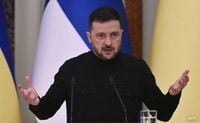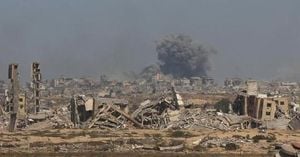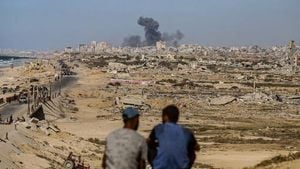On October 4, 2025, the city of Shostka in Ukraine’s northeastern Sumy region was rocked by a devastating Russian drone strike that left at least 30 people wounded and a community reeling. The attack, which Ukrainian President Volodymyr Zelensky condemned as “savage,” targeted a bustling railway station just 70 kilometers from the Russian border. Among those injured were railway staff, passengers, and at least three children, with some requiring urgent hospitalization, according to Ukraine’s national rail operator, Ukrzaliznytsia.
Images and videos shared by President Zelensky and local officials painted a harrowing picture: a passenger carriage engulfed in flames, twisted metal, and windows blown out by the blast. "The Russians could not have been unaware that they were striking civilians. And this is terror the world must not ignore," Zelensky wrote on social platform X, as reported by Nexstar Media Inc. Emergency services rushed to the scene, providing medical assistance and sheltering survivors, while the air raid alert remained in effect for hours after the initial impact.
The strikes unfolded in two rapid waves. According to Ukraine’s deputy prime minister and reconstruction minister, Oleksiy Kuleba, Russian drones first hit a local commuter train before targeting a second train bound for Kyiv. The second strike, which occurred during evacuation efforts, exemplified what Ukrainian officials have described as a brutal “double strike” tactic—deliberately hitting rescuers and civilians attempting to flee or help the injured. "This is one of the most brutal Russian tactics — the so-called ‘double strike,’ when the second strike hits rescuers and people who are evacuating," Ukraine's top diplomat Andrii Sybiha told international media.
The aftermath was grim. Hours after the attack, local authorities discovered the body of a 71-year-old man in the wreckage of a train carriage, raising the human toll even further, as reported by European news outlets. The drone strikes also caused widespread power outages in Shostka and neighboring areas, leaving tens of thousands without electricity. Local governor Oleh Hryhorov confirmed that the power supply in Shostka—once home to about 70,000 residents before the war—had been knocked out, compounding the misery for civilians already bracing for another harsh winter.
This latest assault comes as part of a broader escalation by Moscow, which has intensified its campaign against Ukraine’s critical infrastructure as the fourth winter since the full-scale invasion approaches. Over the past two months, Russian forces have targeted Ukraine’s railway and power grids almost daily, seeking to cripple military logistics and sap civilian morale. On the night of October 3 into October 4 alone, Russia launched 109 drones and three ballistic missiles at Ukraine, according to the Ukrainian military. Of these, air defense forces managed to intercept or divert at least 73 drones, but the sheer scale of the attacks has left energy facilities and transport hubs vulnerable.
Just a day before the Shostka strike, Ukrainian officials reported the largest attack on the country’s natural gas facilities since the invasion began in February 2022. Russia fired a staggering 381 drones and 35 missiles, targeting the state-owned Naftogaz Group’s infrastructure in what Kyiv described as an attempt to "terrorize civilians" and weaponize the coming winter. "The attacks had no military purpose," stated Naftogaz’s chief executive Serhii Koretskyi, while Prime Minister Yulia Svyrydenko accused Moscow of "terrorizing civilians." Russian officials, for their part, insisted the strikes were aimed at facilities supporting Ukraine’s war effort.
The damage to Ukraine’s energy grid has been severe. In Chernihiv, a city west of Shostka and also near the Russian border, overnight strikes on October 4 damaged energy facilities and triggered blackouts affecting roughly 50,000 households, as confirmed by the regional operator Chernihivoblenergo. Fires raged through the night, and local military administration head Dmytro Bryzhynskyi reported multiple blazes but withheld details about the exact targets.
Ukraine has not remained passive in the face of these attacks. On the same day as the Shostka railway strike, Ukrainian forces reportedly hit one of Russia’s largest oil refineries—the Kirishi refinery near St. Petersburg—with a nighttime drone assault. The refinery, operated by Surgutneftegas, is a key node in Russia’s energy network, producing about 17.7 million metric tons of crude annually. Videos circulating on Russian and Ukrainian Telegram channels showed the sky lit by orange glows as explosions thundered in the distance. Local Russian governor Alexander Drozdenko confirmed that seven drones were shot down and a fire was extinguished in the refinery’s industrial zone, though he did not comment on the extent of the damage.
Repeated Ukrainian strikes on Russian energy infrastructure—including a previous attack on Kirishi on September 14—have contributed to fuel shortages within Russia. In response, the Kremlin extended a ban on gasoline exports until the end of the year and prohibited the sale of various fuels abroad by resellers. According to Russia’s Kommersant business daily, the domestic gasoline shortage has reached 20%, or about 400,000 tons per month. The Kremlin’s moves underscore the economic pressures both sides face as the war grinds on.
The violence has not spared journalists, either. On October 3, a Russian drone strike near Druzhkivka in eastern Ukraine killed French photojournalist Antoni Lallican, according to the Ukrainian military. Lallican, whose work appeared in Le Monde, Le Figaro, Der Spiegel, and Die Zeit, was the 14th reporter killed since Russia’s full-scale invasion began. Three other French journalists—Arman Soldin, Frédéric Leclerc-Imhoff, and Pierre Zakrzewski—have also lost their lives covering the conflict.
President Zelensky’s response to the latest attacks was both urgent and resolute. "Every day, Russia takes people’s lives. And only strength can make them stop. We’ve heard resolute statements from Europe and America — and it's high time to turn them all into reality, together with everyone who refuses to accept murder and terror as normal. Lip service is not enough now. Strong action is needed," he declared, as quoted by Nexstar Media Inc. The Ukrainian leader’s call for more robust international support comes amid ongoing debates in Western capitals about the scope and scale of future aid to Kyiv.
Despite repeated appeals for a ceasefire and mounting global condemnation, diplomatic efforts remain stalled. Even high-profile meetings—such as the one between former U.S. President Trump and Russian President Vladimir Putin in Alaska last August—have failed to yield tangible progress. Sanctions, too, have not deterred the Kremlin from its campaign, and the war shows little sign of abating as winter looms.
As Shostka’s residents pick up the pieces and mourn their losses, Ukraine’s battered railways and power grids stand as stark reminders of the conflict’s human and infrastructural toll. The attacks on October 4 may have been just another day in a long, grinding war, but for those caught in the crossfire, the scars will linger far beyond the headlines.




